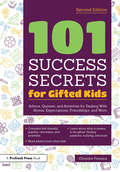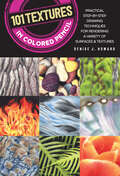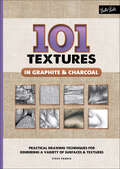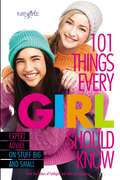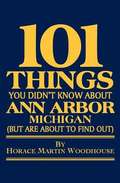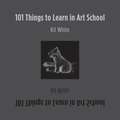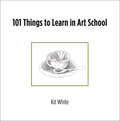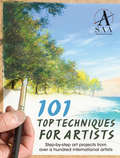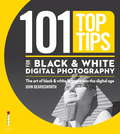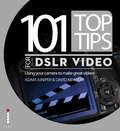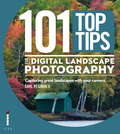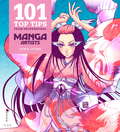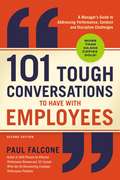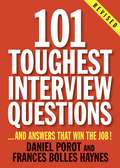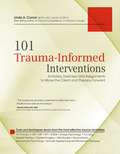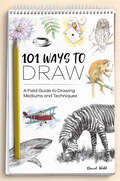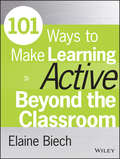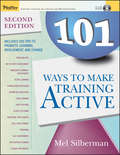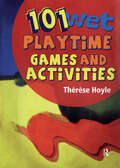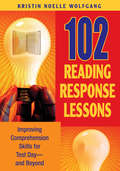- Table View
- List View
101 Success Secrets for Gifted Kids: Advice, Quizzes, and Activities for Dealing With Stress, Expectations, Friendships, and More
by Christine FonsecaPssst! Want to know a secret? Want to help gifted kids harness the power of their giftedness? The second edition of 101 Success Secrets for Gifted Kids is a must-read for gifted kids ages 8 to 12 who want to find success in school, relationships, and life. This book:Includes 101 awesome secrets, tips, and tricks for gifted kids.Is chock-full of fun quizzes, activities, and practical strategies.Covers bullying, school performance, perfectionism, friendships, sibling rivalries, and managing intensities.Features Q & A sections from other gifted kids and preteens.Gives gifted kids insight into everything they've ever wanted to know about being gifted.Proven strategies for dealing with stress management, parents' and teachers' expectations, anxiety, cyberbullying, friendship troubles, and more make this the must-have guide for every gifted kid.Ages 8-12
101 Textures in Colored Pencil: Practical Step-by-Step Drawing Techniques for Rendering a Variety of Surfaces & Textures (101 Textures Ser.)
by Denise J. HowardCapture the feel of your subject on paper. Learn every technique you’ll need to give your colored-pencil drawings realistic, palpable texture.Named One of the 54 Best Colored Pencil Drawing Books of All Time by BookAuthority*There has never been a better opportunity to master textures. Knowing how to make your surfaces and textures look real is one of the most challenging aspects of creating art in colored pencil, even for experienced artists. 101 Textures in Colored Pencil provides artists with step-by-step instructions for drawing a wide variety of the most common textures and surfaces, including sand, water, metals, foliage, wood, fabrics, stone, grass, hair, and many more.To get you started, this comprehensive guide opens with a review of tools and materials as well as basic skills, such as strokes, effects, and color mixing. Plus, the book is organized into sections based on subject matter, so you can easily find the specific texture you’re looking for. Just a sample of the textures you will learn to render:People: smooth skin; aged skin; straight, curly, and wavy hair; lipsAnimals & Insects: smooth, curly, and course canine fur; elephant skin; feather; fish scalesFabrics & Textiles: burlap, tweed, silk, velvet, leather, lace, sequinsGlass, Stone, Ceramics, Wood & Metal: porcelain, polished silver, hammered brass, peeling paintFood & Beverage: red wine, cut citrus fruit, coconut, peach, dark chocolateNature: smooth and rough bark, moss, river pebbles, still and rippled lake, clouds101 Textures in Colored Pencil includes all the textures you need to create realistic masterpieces in colored pencil.
101 Textures in Graphite & Charcoal: Practical Drawing Techniques for Rendering a Variety of Surfaces & Textures
by Steven Pearce101 Textures in Graphite & Charcoal is a must-have resource for all graphite and charcoal artists. This guide provides step-by-step instructions on drawing key textures you'd find in any illustration. Accurately rendering surfaces and textures is one of the most challenging aspects of working with graphite pencil and charcoal. 101 Textures in Graphite & Charcoal provides artists with step-by-step instructions for learning how to draw a wide variety of the most common textures and surfaces, including sand, water, metals, foliage, wood, fabrics, stone, grass, hair, and many more. Opening with a general introduction to basic drawing tools, materials, and drawing techniques, each page in this comprehensive resource features two to three easy-to-follow steps demonstrating how to create each specific texture. You will will discover tips and techniques for working in both graphite and charcoal and how to manage their differences when hatching, stippling, scumbling, blending, and more. With its breadth of coverage, easy-to-follow instruction, and helpful tips, 101 Textures in Graphite & Charcoal is a must-have resource for artists of all skill levels.
101 Things Every Girl Should Know: Expert Advice on Stuff Big and Small (Faithgirlz)
by From the Editors of Faithgirlz!The editors of Faithgirlz! and Girls' Life have collected their best advice to help girls take charge and feel confident in a variety of situations, from changing a bike tire to talking to your teacher about a bad grade, from being threatened by a bully to falling down the stairs at school. What do you do when you’re at a party and you don’t know anyone? What’s the formal way to set a table (and why does it matter)? This random collection of problem-solving strategies helps with everyday stuff, big and small. With tips, advice, and lots of humor, this is a book every girl needs.
101 Things I Learned In Architecture School
by Matthew Frederick2008 Silver Award Winner, Architecture Category, Independent Publisher Book Awards. and Winning entry, General Trade Illustrated Category, in the 2008 New England Book Show sponsored by Bookbuilders of Boston. This is a book that students of architecture will want to keep in the studio and in their backpacks. It is also a book they may want to keep out of view of their professors, for it expresses in clear and simple language things that tend to be murky and abstruse in the classroom. These 101 concise lessons in design, drawing, the creative process, and presentation--from the basics of "How to Draw a Line" to the complexities of color theory--provide a much-needed primer in architectural literacy, making concrete what too often is left nebulous or open-ended in the architecture curriculum. Each lesson utilizes a two-page format, with a brief explanation and an illustration that can range from diagrammatic to whimsical. The lesson on "How to Draw a Line" is illustrated by examples of good and bad lines; a lesson on the dangers of awkward floor level changes shows the television actor Dick Van Dyke in the midst of a pratfall; a discussion of the proportional differences between traditional and modern buildings features a drawing of a building split neatly in half between the two. Written by an architect and instructor who remembers well the fog of his own student days, 101 Things I Learned in Architecture Schoolprovides valuable guideposts for navigating the design studio and other classes in the architecture curriculum. Architecture graduates--from young designers to experienced practitioners--will turn to the book as well, for inspiration and a guide back to basics when solving a complex design problem.
101 Things I Learned® in Law School (101 Things I Learned)
by Matthew Frederick Vibeke Norgaard MartinA provocative, accessible, and cleverly illustrated guide to legal principles and practice, by a law instructor and internationally experienced attorneyThis might be the most useful book law students ever read. Not because it contains the details of case law, but because it teaches them how to think like a lawyer. From the fundamentals of effective argument to the principles, structures, and assumptions underlying our legal system, 101 Things I Learned in Law School makes the impenetrable clear and the complex understandable. Illustrated lessons summarize landmark cases and illuminate a fascinating range of questions, including: * What is the difference between honesty and truthfulness? * Why is circumstantial evidence often better than direct evidence? * How does one find the proper sources to substantiate a legal argument? * Why do states deliberately pass unconstitutional laws? * How can testimony from a hostile witness be helpful?Written by an internationally experienced attorney and law instructor, 101 Things I Learned in Law School is a concise, highly readable resource for law students, graduates, professionals, and anyone else fascinated--or confused--by our legal system.
101 Things I Learned® in Psychology School (101 Things I Learned)
by Tim BonoWhy do we think, feel, and act the way we do? A professor and expert consultant on psychological health ponders these questions and more in this thought-provoking, illustrated guide.Psychology is one of the most popular undergraduate majors. It provides an orienting point for many professional careers, including international relations, public health, social work, clinical counseling, brain research, organizational behavior, business, and advertising. This book not only provides an introduction to this vast field but also tells you how to survive and thrive in the psychology curriculum. Lessons include: • the essential organization and workings of the brain • why statistics and the scientific method are as critical to the psychologist as humanistic skills • how to conduct research, structure survey questions, organize data, and present a research paper • how a therapist and patient form an alliance • why forgetting makes the mind more efficient • why shame is destructive while guilt is productive Written by an experienced professor, author, and expert consultant on mental health and happiness, 101 Things I Learned® in Psychology School is for students as well as beginning clinicians, social and public health workers, and others interested in understanding why we think, feel, and act as we do.
101 Things You Didn't Know About Ann Arbor, Michigan (But Are About To Find Out)
by Horace WoodhouseAfter you've browsed through this little book, you will better understand why Ann Arbor has a greater quirk quotient than most places. To prove his point, your curious author has dug up bits of esoterica - odd, amusing, and little-known strands that make up the city's variegated fabric. Sure, you live here, but how much do you really know about Ann Arbor? Can you name your hometown football legends, Playboy Magazine playmates, 1960s radicals, NASA astronauts, the local boxer who fought Jack Dempsey, the brainy UM graduate who attempted the perfect crime, or the local girl who flirted with Humphrey Bogart in "The Big Sleep"? Who was the native industrialist who helped build the Panama Canal? Or the Ann Arborite who created the world's largest technology company? How did a border dispute lead to the greatest rivalry in college football? Where is the city's only Frank Lloyd Wright-designed house? What is Ann Arbor's connection a Presidential assassination? Readers learn the answers to these intriguing questions and much, much more. Fascinating tangents and tidbits in purposely random sequence (with generous cross-references) create a ready-to-explore trail of knowledge about Ann Arbor and its environs, informing and entertaining, correcting myths and misconceptions, mostly revealing an unexpected treasure trove that brings a culture and a place into sharp focus.
101 Things to Learn in Art School
by Kit WhiteArtist and teacher White delivers and develops art school lessons, striking an instructive balance between technical advice and sage concepts. These 101 maxims, meditations, and demonstrations offer both a toolkit of ideas for the art student and a set of guiding principles for the artist.
101 Things to Learn in Art School
by Kit WhiteLessons, demonstrations, definitions, and tips on what to expect in art school, what it means to make art, and how to think like an artist.What is the first thing to learn in art school? “Art can be anything.” The second thing? “Learn to draw.” With 101 Things to Learn in Art School, artist and teacher Kit White delivers and develops such lessons, striking an instructive balance between technical advice and sage concepts. These 101 maxims, meditations, and demonstrations offer both a toolkit of ideas for the art student and a set of guiding principles for the artist. Complementing each of the 101 succinct texts is an equally expressive drawing by the artist, often based on a historical or contemporary work of art, offering a visual correlative to the written thought. “Art can be anything” is illustrated by a drawing of Duchamp's famous urinal; a description of chiaroscuro art is illuminated by an image “after Caravaggio”; a lesson on time and media is accompanied by a view of a Jenny Holzer projection; advice about surviving a critique gains resonance from Piero della Francesca's arrow-pierced Saint Sebastian.101 Things to Learn in Art School offers advice about the issues artists confront across all artistic media, but this is no simple handbook to making art. It is a guide to understanding art as a description of the world we live in, and it is a guide to using art as a medium for thought. And so this book belongs on the reading list of art students, art teachers, and artists, but it also belongs in the library of everyone who cares about art as a way of understanding life.
101 Top Techniques for Artists
by Saa101 Top Techniques for Artists is a colourful compendium packed full of practical tips and techniques by 101 of today's most popular leading artists. Each technique is presented in clear, simple step-by-step instructions that describe how to complete the project yourself, including a full list of materials and detailed images to guide you along the way.Divided into seven chapters that cover watercolours, acrylics, oils, pastels, drawing and mixed media, this handy book is bursting with some of the most popular styles and subjects, designed to showcase the very best of artistic abilities available to help develop your own creative streak.All contributors featured in this book are professional artists belonging to the SAA, who together with a global community of over 46,000 other members, make up the world's largest and friendliest art society. Whether you're a beginner, an improver or a professional, there's something new to learn for everyone in this comprehensive collection.
101 Top Tips for Black & White Digital Photography: The Art of Black & White Brought into the Digital Age
by John BeardsworthA comprehensive look at black & white photography by one of today's leading experts on digital-editing software and black & white conversion techniques.John Beardsworth explores the most powerful software for converting your color shots into stunning, high-quality black-and-white photos, with detailed explanations of how each tool works and why to try it out on your own images. His streamlined methods will optimise your workflow and inspire your photography.In addition to providing an abundance of step-by-step instructions with brilliant imagery, Beardsworth also teaches the aesthetic value of black and white, and how to visualise the creative potential of each shot. With its fun and approachable tips-based structure, this book will motivate you to experiment with impressive effects and innovative tools, ensuring that you make full use of the B&W software at your disposal.
101 Top Tips for DSLR Video
by David Newton Adam JuniperAll the information a photographer or film-maker needs to create cinema-quality movies with their digital SLR.
101 Top Tips for DSLR Video: Using Your Camera To Make Great Movies
by David Newton Adam JuniperFollowing the arrival of game-changing new cameras from Nikon and Canon, the hottest area in the world of photography has been combining high-definition video capability with all the advantages of SLR's interchangeable lenses. For the first time, full cinematic creativity is within anyone's grasp.With its tips-based structure, this book can be dipped into for reference for movie-makers of any background, or read cover to cover for a complete course in movie-making. With four case studies from real-world professional projects, including a TV advertisement and a music video, 101 Top Tips for DSLR Video provides invaluable guidance for any budding filmmakers.Top Tips for DSLR Video also includes four case studies from real-world professional projects, including a TV advertisement and a music video. Taking you all the way from understanding and choosing the technology, to planning, shooting, editing, and finally publishing your movie, this book contains everything you really need to know about making video with your digital SLR camera.
101 Top Tips for Digital Landscape Photography: Capturing Great Landscapes With Your Camera (101 Top Tips Ser.)
by Carl Heilman IIA comprehensive guide to improving your landscape photography by one of today's foremost landscape photographers.Landscape photography is perhaps the single most popular genre among DSLR owners. In 101 Top Tips for Digital Landscape Photography, experienced professional landscape guru Carl Heilman II gives the benefit of a lifetime spent shooting spectacular wilderness and mountain shots, offering a host of targeted tips and tricks that will allow photographers of all abilities to lift their landscape work to the next level.The reader will learn how to harness natural drama, use difficult lighting situations to your advantage and capture unusual perspectives, all the while benefiting from Carl's clear instruction and beautiful landscape work.
101 Top Tips from Professional Manga Artists
by Sonia Leong Meredith WalshAs a sophisticated and highly stylised art form, Manga presents a series of challenges for budding artists, from character and set design to creating dynamic page layouts, perfectly paced narrative and panels with ever-changing camera angles.Here, award-winning professional Manga artist Sonia Leong and a collective of acclaimed creators lay bare the expert techniques that you need, from essential drawing tips to designing characters, painting vivid illustrations and exciting storytelling.Manga comes in a variety of styles, from kawaii (cute) to hyper-realistic. 101 Top Tips from Professional Manga Artists identifies the key features of each, enabling you to develop your individual style.Including both traditional and digital art methods alongside tips on becoming a professional, 101 Top Tips from Professional Manga Artists is the ultimate resource for beginners and more experienced artists alike.
101 Tough Conversations to Have with Employees: A Manager's Guide to Addressing Performance, Conduct, and Discipline Challenges
by Paul FalconeThis second edition of the bestselling guide by top human resources author Paul Falcone provides guidance for managers, including sample dialogues for how to broach uncomfortable conversations across a wide range of issues.Inappropriate workplace conduct, lateness, sexually offensive behavior, productivity and communication issues . . . these are just a few of the uncomfortable topics bosses must sometimes discuss with their employees. 101 Tough Conversations to Have with Employees offers realistic sample dialogues managers can use to facilitate clear, direct interactions with their employees, helping to sidestep potential awkwardness and meet issues head-on. This practical, solution-oriented book walks readers through some of the most common—s well as the most serious—employee problems they are likely to encounter. While covering everything from substandard performance reviews to progressive disciplinary warnings and termination meetings, the second edition of this bestselling resource offers readers twenty new scenarios covering current hot-button issues like FMLA abuse and ADA accommodations, wage and hour challenges, team turnarounds, and compensation conflicts. This handy guide helps managers treat their people with dignity and respect, focusing not just on what to say but also on how to say it. It provides proven techniques managers can use to protect themselves and their organizations—and get the very best from their people.
101 Toughest Interview Questions: And Answers That Win the Job!
by Frances Bolles Haynes Daniel PorotNothing is more crucial to landing your dream job than a stellar performance in the all-important interview, that nerve-wracking final step to every job search. Extensively updated and revised for today's highly competitive employment market, this compact, concise handbook will prepare you for the most challenging and frequently asked questions you can expect to encounter. Following each question is a list of savvy, can't-miss sample answers, which can be easily modified to reflect your own experience level, skills, and qualifications.
101 Trauma-Informed Interventions: Activities, Exercises and Assignments to Move the Client and Therapy Forward
by Linda A. CurranThis is the workbook that all mental health professionals wish they had at the beginning of their careers. Containing over 100 approaches to effectively deal with trauma, this workbook pulls together a wide array of treatments into one concise resource. Equally useful in both group and individual settings, these interventions will provide hope and healing for the client, as well as expand and solidify the professional's expertise.
101 Ways to Draw: A Field Guide to Drawing Mediums and Techniques
by David WebbMaster and combine different media in your drawing—from soft pencils to graphite powder, ballpoint to fiber-tip pens, conté sticks to watercolor pencils.This visual directory of drawing techniques beyond the pencil provides you with the skills to explore and experiment with all the different techniques and mediums. Use it as a handy reference for when you want to know how to use a particular tool, or as a catalogue of inspiration when seeking new ideas to try.A wealth of media and equipment is demonstrated, and each page features invaluable information for beginners and accomplished artists alike. As the techniques progress, you’ll explore the creative possibilities beyond one medium, and be encouraged to look at your work and style in a new light.Start with basic graphite pencils, sticks and powder to explore line and tone, shading, creating textures and erasing. Then move on to coloured pencils to cover techniques such as burnishing, lifting and sgraffito. There are various interesting methods to try with water-soluble coloured pencils too, including different ways of applying water, blending and overlaying colours.There are some really interesting ways to use ink pens for painting effects and instructions are included for cutting your own quill pen. Ballpoint pens, fiber-tips, marker pens and brush pens are also great tools for creating modern, graphic drawings—pick up some handy tips for mark making and blending.Finally, experiment with mixed media and combining various pencils, pastels, crayons, powder, sticks and pens for some stunning results. Be inspired by the huge range of drawings in this book to expand and develop your own skills.
101 Ways to Make Learning Active Beyond the Classroom
by Elaine BiechFresh, creative strategies guaranteed to enliven online training 101 Ways to Make Learning Active Beyond the Classroom provides proven, practical strategies, activities, and tips for those tasked with facilitating training in any subject area among alternative settings. Based on the best-selling Active Training approach, these methods have been designed by recognized experts, and are guaranteed to enliven any learning event. Readers will find a toolkit of ready-to-use exercises and tips for organizing, conducting, and delivering active learning, in alternative settings on the job or around the world. The book is organized in a way that allows trainers to quickly and easily identify strategies that hold the most promise for specific situations. Each strategy is illustrated with a case example that demonstrates the concepts in action. Two hundred tips organized in twenty how-to lists will prove invaluable for using Twitter, coaching virtually, encouraging informal learning, opening interactive virtual learning sessions, and much more. Coverage includes best practices for social media and informal learning, common e-learning tools, as well as guidance toward using a full gamut of tools from gamification and simulation to serious games and m-learning. Active training encourages participants to use their brains to study ideas, solve problems, and apply what they've learned. It's a fast-paced, fun, supportive, and personally engaging environment. This book shows training facilitators the proven techniques that help learners get more out of the material. Design a more engaging learning environment Improve delivery with optimized technology Utilize effective learning tools and practical strategies Learn best practices for social media, coaching, virtual learning, and more Learners need to figure things out by themselves, ask questions, practice skills, and transfer skills and knowledge to the job. With proven strategies designed by industry leaders, 101 Ways to Make Learning Active Beyond the Classroom is the indispensable guide to the design and delivery of effective alternative ways to learn.
101 Ways to Make Training Active
by Melvin L. SilbermanWhen it was first published in 1995, Mel Silberman's 101 Ways to Make Training Active became an instant bestseller. Now this revised and updated second edition offers the same dynamic approach and several completely new case examples. The examples support each exercise and highlight real-time uses of the highly successful Active Training method. In addition, the book includes 200 training tips that form the nuts-and-bolts of successful active training. These tips incorporated in the book's top ten lists show how to build quality, activity, variety, and direction into your training programs.For the first time 101 Ways to Make Training Active features a CD-ROM containing all the original "Top Ten Trainers Tips and Techniques" lists for easy reproduction and distribution.
101 Wet Playtime Games and Activities
by Therese HoylePicture this, you are a busy classroom teacher, it's almost lunchtime on a Tuesday and it has started to pour with torrential rain. If your school has a wet playtime policy then everyone in the school will be clear about the procedures, your wet play box will be organised and children will have a stimulating, rewarding playtime experience. However, if you are like a lot of schools across the country you will be scrambling around trying to find activities to entertain the children or you will have just discovered your wet play box needs replenishing! The problem with wet playtimes is that they happen haphazardly, we never know when they are going to occur and often we are completely unprepared. The aim of this book is to make sure you are prepared and that you have a wealth of ideas up your sleeve. Through intensive research, the author gathered feedback from teachers, children, lunchtime supervisors, parents and classroom assistants and discovered that you wanted a book that is inspiring, user friendly, and packed with activities, games and ideas that are easy to implement. To make it as easy as possible to use, it includes lots of copiable activities and ideas that support schools in creating a wet playtime policy that will lead to happier playtimes. It includes the following: Easy to run, stimulating activities and games that can be quickly organised at short notice. A selection of copiable resources that can be quickly printed off the CD-ROM or photocopied from the book. Ideas to help implement a wet playtime policy. Creative ideas to support you in organising wet play. Structures for behaviour management at wet playtimes including rewards and encouragers to celebrate children who play well. Suggestions for wet play activity boxes and lots of creative ideas for your wet play themed boxes. So here it is, jam packed with creative ideas, activities, games and activity pages to make those rainy days rainbow filled. Have fun and remember, 'Play is regarded as essential to life long learning, creativity and wellbeing,' Wood (2007).
101 top tips From Professional Manga Artists
by Sonia LeongThe great popularity of Japanese comics and animated media has made manga art one of the hottest commodities in today's commercial art market. 101 Top Tips from Professional Manga Artists shows illustrators how to succeed in that market. Written by two successful manga artists, with additional insights from a select group of fellow professionals, this illustration-packed book covers all aspects of manga art, presenting advice and instruction on-- Research and inspiration for graphic and story ideas Tools and equipment Drawing characters, with attention to hairstyles, expressions, and poses Adding backgrounds, props, and elements from nature Creating illustrations in black and white, in color, painting in Photoshop, and using markers Creating comics with story, script, speech bubbles, and graphic sound effects Preparing finished work for the web and for print Here in a single volume is virtually everything an illustrator needs to know in order to create successful manga art for a variety of media. More than 400 color illustrations.
102 Reading Response Lessons: Improving Comprehension Skills for Test Day--and Beyond
by Kristin Noelle WolfgangUsing this classroom-tested five-step process, your students will learn to dismantle even the most challenging comprehension questions and respond in clear, sophisticated paragraphs.
